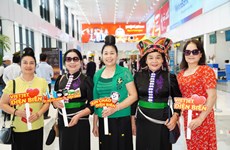New community tour sites to be built in Da Nang
 Co Tu people perform a traditional dance in an event celebrating new rice crop in Ta Lang village in Hoa Vang district of Da Nang. (Photo: VNA)
Co Tu people perform a traditional dance in an event celebrating new rice crop in Ta Lang village in Hoa Vang district of Da Nang. (Photo: VNA) Da Nang (VNA) - The central city of Da Nang has piloted the three first community-based tourism sites in suburban Hoa Vang district as rural ethnic and farm experience attractions in the Master Plan 2025-2030.
The city said the three sites feature the traditional culture of Co Tu ethnic minority people and old-style rural villages.
Ta Lang and Gian Bi – two villages of the Co Tu community – have preserved their brocade weaving, architecture of Guol (traditional communal house) and natural landscapes of primary forest, springs and waterfalls.
Local ethnic people still practise daily lifestyle and annual festivals of Co Tu in a rare community that avoided the rapid urbanisation of the city’s downtown area 40km away.
Thai Lai village in Hoa Nhon commune is home to ancient houses that were preserved from two centuries ago. The architecture of old houses and gardens in the style of central Vietnam were still well protected.
Following the city’s tourism development plan, Tuy Loan village – which hosts an annual traditional festival with a procession of certificates conferred by the Nguyen Dynasty on the village founders in 1470 on the ninth day of the lunar January – will develop as a farm-experience attraction.
The village, which was recognised as a national culture relic in 1999, reserves a large area for vegetable farming, and supplies a major source of farm produce for the city.
Rural lifestyle, farm experience and farm stay services have been developed at the village for hosting tourists from 2025.
According to the city’s Department of Tourism, other rural villages including Thach Nham Tay, Thai Lai, Phu Tuc, An Dinh, Pho Nam and Loc My have potential for camping, forest trekking and mountain climbing as well as river tours and adventurous trips.
These villages, just an hour from the city, will act as unique tourism attractions after beach and nature vacation sites in My Khe, Son Tra Nature reserve and Ba Na Hills.
Covering over 1,250 square metres, Da Nang is cited as an entrance to four World Heritage areas including the former royal capital city of Hue, Hoi An ancient city and My Son Sanctuary in Quang Nam province and UNESCO-recognised Phong Nha-Ke Bang in Quang Binh Province.
It has a total of 90 kilometres of coastline and dozens of beaches, including stunning My Khe. Meanwhile, the city’s Ngu Hanh Son district is renowned as a centre for stone art, with Non Nuoc craft village stands at the foot of the Marble Mountain.
Last year, Da Nang was ranked first among Vietnamese tourists’ popular destinations by Agoda, one of the world’s fastest growing online travel booking platforms.
The city welcomed 8.69 million holidaymakers, including nearly 3.5 million foreigners, up 30.7 percent from the previous year.
As of December 2019, 35 international and 10 domestic air routes respectively operated 496 and 662 flights per week to the central coastal city.
The central coastal city aims to serve 9.8 million tourists in 2020, a year-on-year rise of 12.74 percent, according to the municipal Department of Tourism.
The number of international visitors is expected to increase by 13-15 percent year-on-year.
The city is building a night economic development plan in the field of tourism to realise the 2020 target.
Besides developing the domestic market, the city will diversify the international one in 2019-2021, focusing on potential markets such as France, Germany, Russia, Australia, North America, and India./.












